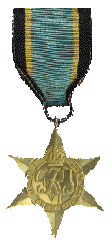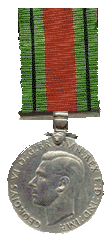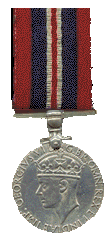
medals
Sgt. Sam Tait's Medals

1939-1945 Star
Terms:
The star was awarded for six months service on active operations for Army and Navy, and two months for active aircrew between 02 September 1939 and 08 May 1945 (Europe) or 02 September 1945 (Pacific).
Bar:
Battle of Britain: This bar was awarded to those members of the crews of fighter aircraft who took part in the Battle of Britain between 10 July and 31 October 1940.
Ribbon:
The ribbon consists of three equal stripes: dark blue, red and light blue (Representing the Navy, Army and Air Force)

Aircrew Europe Star
Terms:
The Star was awarded for two months of operational flying from the UK over Europe between 03 September 1939 and 05 June 1944. It was not awarded after D-Day. The Aircrew Europe Star may not be awarded until the1939-1945 Star has been qualified for by 60 days service in an air operational unit. The total requirement to earn both stars is four months (120 days). A crewman was not awarded this medal if he was killed in action or shot down and made P.O.W. before he reached 60 days.
Bar:
If later entitled to a second or third star, its bar would be worn: ATLANTIC or FRANCE AND GERMANY
Ribbon:
The ribbon is light blue with black edges with narrow yellow stripes between the blue and black (representing continuous service by day and night).


Defence Medal
Terms:
Service in the forces in non-operational areas subjected to air attack or closely threatened, providing such service lasted for three or more years. Service overseas or outside the country of residence, providing that such service lasted for one year, except in territories threatened by the enemy or subject to bomb attacks, in which case it was six months prior to 02 September 1945. The qualifying period in mine and bomb disposal was three months. Those awarded the GC or GM for civil defence received this medal. Home Guard and others in Britain qualified for this medal.
Bar:
There was no bar to this medal.
Description:
A circular, silver (.800 fine) medal, 1.42 inches in diameter. The British issue medals were made of cupro-nickel.
Obverse:
The obverse shows the bareheaded coinage effigy of King George VI, facing left, and the legend: GEORGEIVS VI D: BR: OMN: REX F: D: IND: IMP:
Reverse:
On the reverse, the Royal Crown rests on the stump of an oak tree, flanked by a lion and lioness. At the top left is the date 1939, and at the top right, the date 1945. In exergue, though not ruled off, is the wording: THE DEFENCE/MEDAL.
Mounting:
A plain, straight, non-swivelling suspender with a single-toe claw.
Ribbon:
The light green ribbon is 1.25 inches wide with a central stripe of orange (0.5" wide) and a narrow black stripe in the middle of each green stripe. The orange (flame colour) represents the enemy attacks on the green land of England and the black represents the blackouts.


War Medal
Terms:
The War Medal was awarded to all full-time personnel of the armed forces and merchant marines for serving for 28 days between 03 September 1939 and 02 September 1945.
Description:
A circular, (.800 fine) silver medal, 1.42 inches in diameter. The British issue medals were made of cupro-nickel.
Obverse:
The obverse shows the crowned coinage effigy of King George VI, facing left, and the legend GEORGIVS VI D: BR: OMN: REX ET INDIAE IMP:
Reverse:
The reverse device shows a lion standing wanton on the body of a double-headed dragon. The dragon's heads are those of an eagle and a dragon to signify the principal occidental and oriental enimies. At the top, just right of centre are the dates 1939/1945 in two lines.
Ribbon:
A plain, straight non-swivelling suspender with a single-toe claw.
Mounting:
The ribbon is 1.25 inches wide and consistes 7 coloured stripes: red, dark blue, white, narrow red (centre), white, dark blue and red.


Bomber Command Medal
Terms:
This prestigious commemorative medal, to be worn with pride not alongside gallantry decorations, but separately and distinctively, is intended to mark the bravery and courage of those who flew, and the dedication and skill of the ground crew whose contribution was so essential.
Available exclusively to veterans of Bomber Command 1939 - 1945 or their next of kin.
Obverse:
The Overse features the Laurel wreathed brevet letters of the aircrew supporting that of their pilot, signifying courage, team spirit and leadership.
Reverse:
The reverse shows a four engine bomber which the inscription A Tribute To The Aircrew Of Bomber Command.
Ribbon:
The ribbon colours of blue grey, midnight blue and flame represent the North Sea, the night sky over enemy territory, the flame of the target and the return trip. This medal is supplied on a single pin ready to wear.


Pollington Airfield Memorial Gardens Medal
Terms:
Issued to the veterans that attended the reunions time and time again, often travelling many miles to attend and sometimes in indifferent health. Intended for those "Pollington Boys and Girls" who came back and issued to them or if they had deceased, to their family members in their memory.
Obverse:
The obverse shows the raised Memorial Stone with the words Pollington Airfield Memorial Garden.
Reverse:
The reverse shows the words "For Services To Country And Honouring The Fallen"
Ribbon:
The ribbon colours of Red, White & Blue chosen to resemble as closely as possible the roundels that were painted on the bombers fuselages.